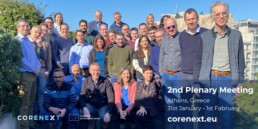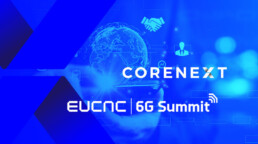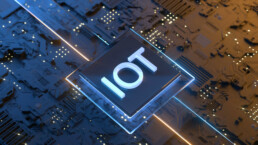COREnext 2nd Plenary Meeting in Athens: project highlights
In the heart of ancient Athens, where history and modernity coalesce, the COREnext team recently convened for the 2nd Plenary Meeting, setting the stage for an enriching two days of collaboration, innovation, and strategic planning. This gathering not only marked a moment of reflection on past achievements but also laid the groundwork for the future trajectory of the COREnext project.

The meeting commenced with a holistic status check, providing an insightful overview of the current state of the COREnext project. Milestones achieved were celebrated, providing a comprehensive understanding of the journey thus far. This introspective analysis served as a catalyst for envisioning future breakthroughs. As the Project Coordinator, Michael Roitzsch from the Barkhausen Institute claimed:
The COREnext project has met in Athens to plan its second year. Hosted by WINGS, we were greeted by nice weather and the Athens Parthenon looking over our meeting location. After having defined an architecture for trustworthy 6G networks in 2023, this year COREnext will build key components to realize this architecture. We brainstormed about research efforts, publications, and demonstrators. A lot of exciting work lies ahead of us!
Platform Architecture Recap
The very essence of COREnext was revisited with a detailed Platform Architecture Recap. Team members delved into the foundational elements, reinforcing the importance of a robust architecture that fosters seamless collaboration and operational efficiency. This session reinforced the commitment to building a technological infrastructure that stands the test of innovation.
The corenext consortium will develop a trustworthy-by-design platform based on a new computing architecture for base stations to push european capabilities in b5g/6g to the next level.
Advancing Use Cases
The meeting showcased tangible progress as the team explored advancements in COREnext's use cases. From ideation to implementation, the project is transforming innovative ideas into tangible solutions that will impact 6G real-world scenarios. This commitment to practical applications reinforces COREnext's role as a driving force in technological advancements.
COREnext, through the use cases, will help define trustworthiness and processing efficiency based on the paramount importance of reliability, availability, security, privacy and integrity for a society based on European values of privacy and data protection.
Strategic Mapping
Eyes set on the future, strategic discussions unfolded as the team mapped out the trajectory for COREnext's ascent to new heights of innovation. These forward-thinking dialogues ensure that the project remains at the forefront of technological advancement, continually pushing boundaries and exploring new frontiers in XR, manufacturing, and automotive.
Global Resonance Through Outreach
COREnext is not merely a local endeavor—it's a global vision. The team unveiled plans for comprehensive outreach activities, ensuring that the project's vision resonates across the tech landscape in Europe. The upcoming white paper, 'Trustworthiness: The Key to Europe's Digital Future,' promises to usher in a new era of insights for the industry, providing a strategic roadmap for cultivating trust in Europe's digital landscape. This strategic approach aims to amplify the European presence of COREnext, fostering collaboration and knowledge exchange on a wider scale.
COREnext Cyber Security Campaign 2023: Unveiling the Growing Threats Across Industries
In an era dominated by technology, the manufacturing industry finds itself at the forefront of an escalating wave of cyber threats. Recent research sheds light on the most pressing concerns facing the sector in the first half of 2023. Here's an overview of some key findings and a few recommendations to navigate the complex cyber landscape.

Manufacturing: A Prime Target
The manufacturing industry is a lucrative target for cybercriminals, hacktivists, and nation-state-aligned attackers. Cybercriminals and hacktivists are drawn to manufacturing due to its low tolerance for outages – disrupting IT services often halts production, resulting in missed revenue. Additionally, state-aligned groups target manufacturing organizations for their links to critical national infrastructure and potential intellectual property treasures.
Nation-state-aligned groups pose a significant threat, exemplified by the China-based advanced persistent threat group Volt Typhoon targeting U.S. critical national infrastructure, specifically manufacturing, in May 2023. Hacktivist group Killnet, aligned with Russia, remains a prominent risk, targeting the aerospace subsector and posing a continued threat in the second half of 2023.
European manufacturing sector accounted 14% of the global incidents, and it’s the 2nd place in the world in 2023. The 1st position belongs to Asia-Pacific region where 61% cases were reported.
Ransomware Reigns Supreme
Ransomware emerges as another significant threat to the manufacturing sector. Cyber attacks surged across all manufacturing sub-groups from the second half of 2022 to the first half of 2023:
- Industrial goods and services organizations faced a 24% increase.
- Aerospace organizations witnessed a staggering 195% surge.
- Chemicals organizations experienced a 92% rise.
- Automobiles and parts organizations encountered a 53% increase.
The Clop ransomware cybercriminals continued its data-theft campaign into the second half of 2023, emphasizing the persistence of this threat. Manufacturing organizations are urged to prioritize measures against ransomware, including regular system patching, data backup, secure storage practices, and proactive threat hunting.
Ransomware dominated the European cybersecurity landscape, constituting 26% of all attacks on the continent. Following closely were server access attacks at 12% and data theft at 10%, ranking as the subsequent prevalent attack types.
Operational Technology Security at Risk
The convergence of operational technology (OT) with traditional IT systems introduces new vulnerabilities. While integrating OT with IT systems enhances performance, it also escalates cyber risk. Attackers target OT systems by exploiting vulnerabilities commonplace across sectors, including unpatched vulnerabilities, weak credentials, and exposed remote services.
The Oldsmar water treatment plant (Florida, USA) incident in 2021 exemplifies the potential consequences. Attackers compromised the network through a dormant TeamViewer remote access account, highlighting the ease with which common IT weaknesses can be exploited to interfere with critical OT systems.
The overarching trend in Europe over the past decade has been the surge in cybercrime, marked by increased tool availability, easier exploit acquisition, and heightened motivation among cybercriminals. Ransomware and extortion campaigns, in particular, have emerged as prominent tools causing significant harm to organizations. Within Operational Technology, there has been an alarming 87% surge in ransomware attacks against industrial organizations, accompanied by a 35% increase in the number of threat groups in 2021.
Strengthening IT/OT Resilience
To enhance resilience against evolving threats, manufacturing organizations are advised to:
- Conduct regular security assessments of OT systems.
- Implement continuous vulnerability assessment and triage.
- Ensure timely updates for key components of the OT network.
- Deploy endpoint detection and response (EDR) solutions for timely threat detection.
- Enhance incident prevention, detection, and response skills through dedicated OT security training.
The interconnected nature of global infrastructure necessitates a proactive, collaborative approach to cybersecurity. By understanding and addressing the evolving threat landscape, manufacturing organizations can fortify their defenses, safeguard critical assets, and contribute to a more secure digital ecosystem.
Source:
https://www.picussecurity.com/resource/blog/regions-and-industries-at-risk-august-2023
https://www.reliaquest.com/blog/cyber-threats-to-manufacturing-industry-1h-2023/
6 Industries Most Vulnerable to Cyber Attack in 2023 (potomac.edu)
The Latest Cyber Crime Statistics (updated October 2023) | AAG IT Support (aag-it.com)
Vulnerabilities Lurking in Today's Digital World
In our world of growing interconnectivity and digital reliance, where smartphones are our constant companions and the internet serves as our primary channel for information and communication, the need for technology to be dependable and reliable has never been more vital. COREnext is a European-funded project to explore and enhance trustworthiness in the context of 5G and 6G technologies. But why is this so important? Let's delve into some basic vulnerabilities in today's systems and society, which COREnext aims to address.
We've heard of hacking, phishing, and spoofing, but what do all these, and others, mean? These issues are like dark clouds looming over our digital lives, threatening to disrupt the sunny days of convenience and connectivity. When vulnerabilities are exploited, the consequences can be far-reaching.

Hacking
Imagine someone picking the lock to your front door, but instead of your home, they're trying to access your personal data. That's what hacking is: a digital break-in. These cybercriminals exploit weaknesses in software or systems to gain unauthorized access. They can steal sensitive information, disrupt services, or even hold your data hostage for a ransom.
Phishing
Phishing is similar to someone pretending to be your trusted friend or family member only to trick you into revealing sensitive information like passwords or credit card details. These ambiguous emails or messages often appear genuine, making it challenging to distinguish them from the real deal.
Spoofing
Imagine receiving a phone call from your best friend, only to find out later it was an imposter. Spoofing means someone hides behind a stolen or made-up identity in communication, which can lead to confusion, deception, or even financial loss.
E-theft
Electronic theft happens when someone steals things from the internet, like personal information, money, or identity. It's like a digital pickpocket. To protect yourself, be careful with your passwords, and don't share them with anyone. Also, watch out for suspicious emails or websites, and always keep your computer and devices updated with the latest security updates. E-theft is a sneaky crime, but simple steps can keep your online world safe.
Data leakage
Data leakage occurs when valuable information, such as your personal data or confidential details, ends up in the wrong hands, either by accident or on purpose. Think of it like a leak in a container holding your information. To safeguard against data leakage, exercise caution when sharing sensitive data online, and always use secure websites and apps. Additionally, be selective about who you trust with your private information. Just as you take care of your personal belongings, it's crucial to protect your data from falling into the wrong hands.

Malware
Malware is harmful software that can attack your computer, steal your data, and cause problems. It comes in various forms like viruses, ransomware, and spyware. To protect yourself, keep your software updated, use good antivirus software, be careful when clicking on unfamiliar links, and regularly back up your data. Learning about cybersecurity is also important to stay safe online.
DDoS - Distributed Denial-of-Services
Sounds complicated? A DDoS attack, normally targeting companies, floods a website or network with so much traffic that it collapses causing financial and reputational damage. Be ready to scale up your network during an attack and consider working with DDoS protection services to detect and mitigate threats quickly.
Cyber Extortion
Cyber extortion happens when bad people use the internet to threaten or pressure others into doing something they don't want. It's like a digital bully who tries to scare you into giving them money or sensitive information. To stay safe from cyber extortion, be cautious about sharing personal information online, and don't respond to threats or demands from strangers on the internet. If you ever feel threatened or pressured online, you must talk to a trusted adult or report it to the authorities. Remember, online safety is just as important as safety in the real world.
So why is COREnext important?
COREnext understands that trust and security are the base of our digital society. Our mission is to fortify the foundations of technology by addressing existing vulnerabilities, to prevent the attacks mentioned above. Through innovative research and development, they aim to create secure, resilient, and trustworthy systems for the 5G and 6G era. COREnext aims to ensure that our digital future remains bright and secure in a world of ever-evolving digital threats.

Safeguarding Trust and Enhancing Resilience in B5G/6G Networks
The landscape of communication in the future will be shaped by the emergence of 6G technology and its architectural innovations, presenting substantial prospects for amplifying and enriching human capabilities. As we move towards the future of wireless communication, the demands on network infrastructure are becoming increasingly complex and diverse.
In that sense, COREnext envisions trustworthiness as a fundamental element. Enhancements to trustworthiness will facilitate the seamless integration of equipment from diverse vendors by service providers. Similarly, hardware and system providers will be empowered to supply and incorporate components into a system that embodies trustworthiness, aligning with European principles of privacy and data protection. The project will emphasise the importance of resilience, availability, security, privacy, integrity, and more; all encapsulated under the umbrella of trustworthiness. These elements will form the bedrock of any forthcoming digital infrastructure, including B5G/6G.
Resilient network infrastructure in the context of B5G/6G refers to a telecommunications framework that is exceptionally robust, adaptable, and capable of withstanding various challenges and disruptions while providing reliable and high-performance connectivity.
Availability refers to the consistent and reliable accessibility of network services and resources to users and devices. It emphasises the network's ability to remain operational and provide seamless connectivity, even in challenging or demanding conditions.
Building trust relies on integrating security and privacy safeguards within the network's signalling and data transmission. A resilient network infrastructure can preemptively recognise potential threats and vulnerabilities, promptly responding with corrective measures in instances of attacks or unforeseen calamities.
In summary, a trustworthy-by-design platform is proposed by COREnext to increase the network's resilience by preventing threats, detecting and mitigating attacks, protecting data, establishing resilient communication channels, ensuring redundancy, and enabling rapid recovery. Trustworthiness enhances the overall robustness and dependability of network infrastructure, leading to improved resilience in the face of challenges and disruptions.
Sources:
Security and trust in the 6G era
D2.1 Use Cases and Requirements
Exploring the Advantages of Smart Cities
A smart city is an urban environment that leverages digital solutions to enhance the efficiency of conventional networks and services (like transportation networks, energy, water & waste management), benefiting residents and businesses. These digital solutions surpass the adoption of digital technologies to improve resource utilization and reduce emissions by encompassing intelligent urban transport systems, modernized water supply and waste management facilities, and optimized methods for lighting and heating buildings. Moreover, a smart city entails an interactive and responsive city administration, prioritizes the safety of public spaces, and caters to the evolving requirements of an ageing population.
In this article, we will address the advantages of smart city applications, which have revolutionized the way cities operate and significantly improved citizens' quality of life. These applications leverage the power of IoT devices, data analytics, and artificial intelligence (AI) to optimize various urban operations, making cities more efficient, sustainable, and safer.
One crucial aspect of smart city applications is public safety systems. Smart cities can detect and respond to public safety incidents using data analytics and AI in real time. For instance, video analytics can be employed to monitor public spaces and identify suspicious behaviour or incidents of violence. The system can automatically alert law enforcement or emergency services when such activities are detected, allowing rapid and proactive responses.
Another significant advantage is Intelligent transportation systems (ITS). These systems integrate various technologies to enhance transportation efficiency, reduce congestion, and improve safety. IoT devices like connected vehicles and traffic sensors collect real-time data on traffic flow, parking availability, and road conditions. This data is then analyzed to optimize traffic management, provide accurate travel information to commuters, and even enable autonomous vehicle operations. Smart cities can reduce travel times, minimize fuel consumption, and improve mobility by optimising transportation networks.
Waste management is another area where smart city applications have significantly impacted. By implementing IoT devices and data analytics, cities can monitor waste levels in real time and optimize collection routes accordingly. Smart bins with sensors can provide information on fill levels, allowing waste management teams to plan efficient collection schedules and reduce costs and environmental impact. By deploying AI algorithms, cities can also analyze historical data to identify patterns and optimize waste disposal practices.
Another example is water management systems, which are vital in ensuring the efficient use and conservation of water resources in smart cities. IoT devices like smart water meters and sensors can collect real-time data on water consumption, leak detection, and water quality. This information is then analyzed to identify areas of high consumption or potential leaks, enabling proactive maintenance and conservation efforts. AI algorithms can optimize water distribution networks, detect anomalies, and predict future water demand, ensuring efficient water usage and reducing water wastage.
Lastly, energy management systems are crucial for creating sustainable and energy-efficient cities. Smart city applications enable the integration of renewable energy sources, such as solar panels and wind turbines, with traditional power grids. IoT devices and data analytics help monitor energy consumption, identify areas of high energy usage, and suggest strategies for energy conservation. AI algorithms can optimize energy distribution, balance supply and demand, and predict potential power outages. Smart cities can reduce their carbon footprint and promote cleaner and more sustainable energy practices by utilising these systems.
In a Smart City, many IoT devices provide information for AI algorithms. In this scenario, the trustworthiness of the devices that provide the information is crucial to avoid a malicious attack. Similarly, the transmitted information must be protected and not accessible from external unauthorized entities.
In summary, smart city applications transform urban landscapes by leveraging IoT devices, data analytics, and AI technologies. These applications enhance various aspects of urban life, including public safety, transportation, waste management, energy usage, and water conservation. By utilizing these intelligent management systems, cities can optimize their operations, improve the quality of life for citizens, and work towards a sustainable and resilient future.
SOURCES:
D2.1 Use cases and requirements
WHAT IS A SMART CITY – TECHNOLOGIES, APPLICATIONS, BENEFITS, AND EXAMPLES
Applications of IoT in Smart Cities
Building Trust in the Dynamic XR Industry: Collaboration for End-to-End Trustworthiness
Extended reality (XR) is a catch-all term to refer to augmented reality (AR), virtual reality (VR), and mixed reality (MR). The technology is intended to combine the physical world with the "digital twin world" while being able to interact with it.
The fields of virtual reality and extended reality are rapidly growing and are being applied in a wide range of areas, such as entertainment, marketing, real estate, training, and remote work.
As this immersive technology gains traction, addressing the emerging challenges associated with trustworthiness becomes crucial. With an array of devices from various vendors flooding the market, it is imperative to create awareness among XR stakeholders about the significance of trustworthiness and establish a foundation of reliability and security. This article delves into the importance of trustworthiness in the XR industry, particularly in integrating equipment from different vendors.
Exploring the World of XR
The XR domain, which includes virtual reality (VR), augmented reality (AR), and mixed reality (MR), has experienced remarkable expansion and evolution. Progress in the development of hardware components like headsets, motion trackers, and haptic devices, combined with breakthroughs in software, have propelled XR to the forefront of groundbreaking innovation. These advancements have unlocked a multitude of captivating possibilities across various sectors, ranging from gaming and healthcare to education and industrial training.
The Need for Trustworthiness
As XR becomes increasingly present) across various industries, ensuring trustworthiness becomes essential. Trust is critical for both end-users and stakeholders within the XR ecosystem. On the one hand, for end-users, trust, reliability, security, and overall performance of XR devices translate into the quality immersive experience they seek. For XR stakeholders, trust translates into building long-term relationships with customers, safeguarding sensitive data, and maintaining a competitive edge in the market.
Challenges of Equipment Integration
One challenge that arises as the XR industry expands is the integration of equipment from different vendors. Service providers often rely on diverse devices to deliver comprehensive XR experiences tailored to specific applications. However, integrating devices from multiple vendors can introduce compatibility issues, interoperability concerns, and potential security vulnerabilities.
End-to-End Trustworthiness
Ensuring end-to-end trustworthiness is essential to address the challenges associated with integrating equipment from different vendors. This involves establishing a holistic approach that focuses on the XR ecosystem's reliability, compatibility, security, and privacy aspects.
Reliability: Devices should meet industry standards, undergo rigorous testing, and provide consistent performance to instil confidence in end-users and stakeholders.
Compatibility: Establishing compatibility guidelines and standards that enable seamless integration of devices from different vendors is crucial. This ensures interoperability and reduces potential issues from mixed hardware and software environments.
Security: XR devices must incorporate robust security measures to protect against unauthorized access, data breaches, and other cyber threats. Encryption, authentication protocols, and secure software development practices should be employed throughout the XR ecosystem.
Privacy: With XR technology capturing and processing vast amounts of user data, protecting privacy is paramount. Stakeholders must adopt transparent data handling practices, provide clear consent mechanisms, and stick to relevant data protection regulations.
Collaboration and Standards
Collaboration among XR stakeholders, including device manufacturers, software developers, service providers, and regulatory bodies, is crucial for establishing trustworthiness. Joint efforts should focus on defining and implementing industry standards that enclose device specifications, software interfaces, security protocols, and privacy guidelines. Open dialogue, knowledge sharing, and cooperation among stakeholders will ensure the development of a robust and trustworthy XR ecosystem.
Education and Awareness
Creating awareness among XR stakeholders is vital for building trustworthiness. Training programs, workshops, and industry events should emphasize the importance of trustworthiness and provide practical insights into integrating devices from different vendors. Encouraging responsible development practices, conducting regular security audits, and staying updated with emerging threats is essential when promoting a culture of trust within the XR industry.
As the XR industry grows, integrating devices from different vendors becomes increasingly prevalent. Trustworthiness is key in ensuring a secure and reliable XR experience for end users. By focusing on end-to-end trustworthiness, collaborating on industry standards, and promoting awareness among stakeholders, the XR industry can grow with confidence, safeguarding user interests and capitalizing on the vast potential of this transformative technology. It will be one of the COREnext use cases.
RESOURCES:
What is the Extended Reality (XR): Complete guide 2023
5 Problems And Solutions Of Adopting Extended Reality Technologies Like VR And AR
Secure and Trustworthy Artificial Intelligence-Extended Reality (AI-XR) for Metaverses
The COREnext Project Takes the Spotlight at EuCNC
This year's EuCNC event holds immense significance as it provides a platform to showcase the visions and early technological advancements in the field of 6G. Following the launch of several regional 6G initiatives, it is gratifying to witness Europe's leading position in mobile communications research, thanks to the Smart Networks and Services (SNS) joint undertaking.
Led jointly by industry and the European Commission, the SNS has formulated the strategy and provided the necessary tools to foster technological capabilities for 6G systems. The SNS has recently initiated 35 projects with a combined funding of approximately EUR 250 million from the European Union. Moreover, this year, there is an anticipated call for project proposals with a budget of EUR 132 million. These efforts encompass the establishment of experimental infrastructures, large-scale trials, and pilots across various industries.
The COREnext project took the stage during the session. It showcased how 6G is envisioned to revolutionize the consumer and enterprise markets, surpassing the achievements of 5G. The key focus was earning users' trust and fostering innovative design to facilitate this evolutionary leap. The session presented various enabling technologies from both a network and device standpoint.
Hosted by Ericsson, a special session took place on the 8th of June at 11:00 CEST. Attendees had the opportunity to gain insights into the future of telecommunications and the role of trust in shaping the 6G landscape.
Several compelling presentations were made during the session, shedding light on various aspects of trustworthiness and innovation in telecommunications. Here's a recap of the topics covered by each speaker:
From Ericsson (SE), Fredrik Tillman started the session by providing an insightful introduction. He set the stage for the subsequent presentations, emphasizing the importance of trust and security technologies in the evolving telecom landscape.
Patrik Ekdahl, also from Ericsson (SE), delved into the telecommunications industry's challenges in implementing secure enclaves. He discussed the significance of protecting sensitive data and ensuring the privacy and integrity of telecommunication networks.
Gerhard Fettweis from Technische Universität Dresden (DE) presented the COREnext project, focusing on the design aspects that enhance trustworthiness. This project aimed to develop innovative solutions and frameworks to establish trust in the rapidly advancing telecom ecosystem.
Anastasia Grebenyuk, another Ericsson (SE) speaker, delved into radio fingerprinting. She highlighted how machine learning algorithms could be leveraged to identify and authenticate radio signals, contributing to telecommunications networks' overall trustworthiness and security.
Panagiotis Demestichas, from WINGS (GR), provided insights into the intersection of trustworthiness and IoT devices. He discussed the challenges and opportunities in ensuring the security and reliability of IoT devices, which play a crucial role in the evolving telecom landscape.
Mario Scillia (BE), from the European Commission, delivered the concluding remarks, summarizing the key takeaways from the session. He highlighted the importance of trust in driving innovation and progress in the telecommunications industry and acknowledged the significant efforts made by the presenters and participants.
The session provided a comprehensive overview of the challenges and advancements in establishing trust in the telecom sector. The presentations provided valuable insights for the attendees, contributing to the overall knowledge exchange and collaboration within the community.
https://youtu.be/LMa0lWwSSFk
Learn more about the project and the chair at the Ericsson session during the EuCNC.
https://youtu.be/scmtEON2f1w
COREnext at the EuCNC
The European Conference on Networks and Communications (EuCNC) and the 6G Summit is set to host a special session on 6G Security and Trust, where the recently launched COREnext project will be on stage. 6G is envisaged to impact the consumer and enterprise markets beyond what is accomplished by 5G today. For this evolution to happen, trust must be earned among users and supported by innovative design. This session will present examples of enabling technologies from a network and device perspective.
The special session, hosted by Ericsson will take place on the 8th of June, at 11:00 CEST.
Programme
- Introduction (5’):
- Fredrik Tillman (Ericsson, SE)
- Secure enclave challenges for telco (15’+5’ Q&A)
- Patrik Ekdahl (Ericsson, SE)
- The COREnext project- enhanced trustworthiness by design (15’+3’ Q&A)
- Gerhard Fettweis (TU Dresden, DE)
- Radio fingerprint using ML algorithms (15’+5’ Q&A)
- Anastasia Grebenyuk (Ericsson, SE)
- Trustworthiness and IoT devices (15’+5’ Q&A)
- Panagiotis Demestichas (WINGS, GR)
- Concluding remarks by the commission (5’)
- Mario Scilia (EC, BE)
For more information: Special Session 11 - EuCNC
Securing IoT Systems: Gathering Data from Vertical Sectors
IoT and Verticals
IoT is key within the CORenext project, but how can we define it? IoT stands for "Internet of Things," which refers to a network of physical objects embedded with sensors, software, and connectivity to exchange data over the Internet. In simpler terms, connecting everyday objects to the internet to communicate with other devices and people.
COREnext also takes care of the implications of the IoT in the Vertical sectors. Verticals refer to specific industries or business areas with unique needs, requirements, and regulations. For example, healthcare, finance, and transportation are all vertical sectors. Each sector has its own challenges, opportunities, and trends that influence the adoption and implementation of IoT solutions. Therefore, IoT solutions and technologies may vary depending on each vertical sector's needs and requirements.
The Need for Security in IoT Data Acquisition
IoT is transforming verticals by interconnecting devices and using data to drive technological advancements. The IoT ecosystem comprises many interconnected devices, networks, and platforms communicating and sharing data in real-time. This interconnectedness also introduces vulnerabilities, making IoT systems susceptible to e.g., security breaches, data breaches, and other cyber threats. As data is collected from diverse vertical sectors, the risk of potential attacks and unauthorized access increases. This is especially critical when dealing with sensitive data related to manufacturing processes, production operations, environmental monitoring, and utility management, which are crucial for the smooth functioning of these verticals; as data acquisition from various sectors becomes more widespread, the more it is crucial to prioritize the security of IoT systems.
Strong security measures must be implemented to achieve this, including end-to-end encryption during data transmission, authentication and authorization mechanisms, security audits to identify vulnerabilities, real-time monitoring and logging, timely software and firmware updates, and education and training programs for stakeholders on IoT security best practices. By implementing these measures, we can enhance the security of IoT systems and better protect against potential cyber threats.
Securing IoT Systems in Vertical Sectors
To ensure security and trustworthiness in IoT systems, adopting robust measures for data acquisition from vertical sectors is essential. Here are some key considerations for securing IoT systems in verticals:
- Implementing End-to-End Encryption: Data transmitted between IoT devices, networks, and platforms should be encrypted to protect it from unauthorized access. End-to-end encryption ensures that data remains secure throughout the transmission process, preventing interception and tampering.
- Authentication and Authorization: Implementing strong authentication and authorization mechanisms ensures that only authorized devices and users can access and manipulate IoT data. This includes using secure authentication protocols, such as two-factor authentication, and setting up proper access controls and permissions.
- Regular Security Audits: Regular security audits and vulnerability assessments help identify and address potential weaknesses in IoT systems. This includes evaluating the security of sensors, actuators, smart meters, and other devices used in vertical sectors and patching vulnerabilities to prevent potential attacks.
- Monitoring and Logging: Implementing robust monitoring and logging mechanisms helps detect and mitigate security breaches in real time. This includes setting up security information and event management (SIEM) systems, intrusion detection systems (IDS), and security analytics tools to monitor IoT systems for suspicious activities continuously.
- Regular Software Updates: Keeping all IoT devices, platforms, and software up-to-date with the latest security patches and updates is crucial for mitigating known vulnerabilities. This includes regularly updating firmware, software, and security configurations on all IoT devices in vertical sectors.
- Training and Awareness: Educating employees and stakeholders about IoT security best practices and raising awareness about potential security risks is vital. This includes training on the safe usage of IoT devices, promoting cybersecurity hygiene, and fostering a security-conscious culture within the organization.
With the increased need for data sharing among multiple domains, devices, verticals and organizations, it is critical to ensure that different components and nodes are trustworthy end-to-end to ensure effective transmission of trustworthy data. By prioritizing security in IoT data acquisition, we can leverage the full potential of data from vertical sectors while mitigating risks and ensuring data integrity and confidentiality.
Sources:
What Are the Key Requirements of IoT Security?
IoT Security Guidelines Overview Document
The challenges of IoT security
THE MOST BENEFICIAL IOT APPLICATIONS: INDUSTRY VERTICALS AND HORIZONTAL ENABLERS
IoT industry and vertical markets
What is the IoT? Everything you need to know about the Internet of Things right now
Ensuring Trustworthiness: The Crucial Role of Privacy in Automotive Infrastructure
As technology continues to evolve, the automotive industry has seen a significant increase in connected vehicles on the road. These vehicles have sensors, memory technologies, wireless communication and other technologies that collect data and communicate with other vehicles and infrastructure components. While these advancements can improve safety, reduce traffic congestion, and increase fuel efficiency, they raise concerns about privacy and security. In this article, we will explore the topic of trustworthiness in automotive infrastructure and its impact on user privacy.
What is Trustworthiness in Automotive Infrastructure?
Trustworthiness in automotive infrastructure refers to the ability of connected vehicles and their components to maintain the privacy and security of the data they collect and use. This includes protecting against unauthorized access, hacking, and other cyber threats. It also includes protecting user privacy by limiting personal information collection and sharing.
Privacy Concerns in Automotive Infrastructure
One of the main privacy concerns in automotive infrastructure is collecting and sharing personal information. This includes information such as a vehicle's location, speed, and driving habits, which can be used to create a detailed profile of a driver's behaviour. This information can be used for targeted advertising, tracking, and surveillance. It can also be sold to third-party companies for various purposes.
Another concern is the potential for cyberattacks. Connected vehicles and infrastructure components are vulnerable to hacking and other cyber threats, which can result in the theft of personal information or the manipulation of vehicle systems. This can lead to serious safety risks and financial and reputational damage.
Ensuring Trustworthiness in Automotive Infrastructure
Several steps need to be taken to ensure trustworthiness in automotive infrastructure. One of the most important is strong encryption and authentication protocols. This can help protect against unauthorized access and ensure that only authorized parties can access sensitive data.
Another important step is the use of privacy-preserving technologies. These technologies can limit the collection and sharing of personal information while still allowing for collecting useful data for traffic management and other purposes.
Finally, it is important to have robust governance and accountability mechanisms in place. This includes clear policies and procedures for the data collection, sharing, and use and the ability to audit and monitor compliance with these policies. It also includes effective enforcement mechanisms, such as fines and penalties for non-compliance.
Trustworthiness in automotive infrastructure is essential to ensure the privacy and security of connected vehicles and their components. While advancements in technology have the potential to improve safety, reduce traffic congestion, and increase fuel efficiency, it is important to consider the privacy and security implications of these advancements. By using strong encryption and authentication protocols, privacy-preserving technologies, protection mechanisms, and complying governance and accountability mechanisms, we can ensure that connected vehicles and infrastructure components are trustworthy and protect user privacy.
Sources:
A privacy-preserving scheme for vehicle-to-everything communications using 5G mobile edge computing
Trustworthiness: A New Name Within Automotive
Control of connected and automated vehicles: State of the art and future challenges
On trust management in vehicular ad hoc networks: A comprehensive review










